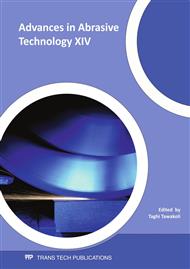[1]
A.W. Momber, and R. Kovacevic, Principles of Abrasive Water Jet Machining. Springer, London. (1998).
DOI: 10.1007/978-1-4471-1572-4_5
Google Scholar
[2]
J. Wang, Abrasive Waterjet Machining of Engineering Materials. Trans Tech Publications, Uetikon-Zuerich, Switzerland (2003).
Google Scholar
[3]
J. Wang, Abrasive waterjet machining of polymer matrix composites-cutting performance erosive process and predictive models. Int. J. Adv. Manuf. Tech., 15(10) (1999), pp.757-768.
DOI: 10.1007/s001700050129
Google Scholar
[4]
J. Wang and W.C.K. Wong, A study of abrasive waterjet cutting of metallic coated sheet steels. Int. J. Mach. Tools Manufact., 39(6) (1999), pp.855-870.
DOI: 10.1016/s0890-6955(98)00078-9
Google Scholar
[5]
E. Lemma, L. Chen, E. Siores and J. Wang, Optimizing the AWJ cutting process of ductile materials using nozzle oscillation technique. Int. J. Mach. Tools Manufact., 42(7) (2002), pp.781-789.
DOI: 10.1016/s0890-6955(02)00017-2
Google Scholar
[6]
J. Wang, Predictive depth of jet penetration models for abrasive water jet cutting of alumina ceramics. Int. J. Mech. Sci., 49 (2007), pp.306-316.
DOI: 10.1016/j.ijmecsci.2006.09.005
Google Scholar
[7]
J. Wang, A new model for predicting the depth of cut in abrasive Water jet contouring of alumina ceramics. J. Mater. Proc. Technol., 209 (2009), pp.2314-2320.
DOI: 10.1016/j.jmatprotec.2008.05.021
Google Scholar
[8]
M. Hashish, Milling with abrasive water jets: a preliminary investigation. Proc. 4th US Water Jet Conf., A.S.M. E, 1987, New York, pp.1-10.
Google Scholar
[9]
H. Hocheng, H.Y. Tsai, J.J. Shiue and B. Wang, Feasibility study of abrasive-waterjet milling of fiber-reinforced plastics. J. Manuf. Sci. Eng., 19(2) (1997), pp.133-142.
DOI: 10.1115/1.2831088
Google Scholar
[10]
Y.X. Feng, C.Z. Huang, J. Wang, and X.Y. Lu, An experimental study on milling Al2O3 ceramics with abrasive waterjet. Key Engineering Materials, 339 (2007), pp.500-504.
DOI: 10.4028/www.scientific.net/kem.339.500
Google Scholar
[11]
Y.X. Feng, C.Z. Huang, J. Wang and H.T. Zhu, A study on the abrasive waterjet milling mechanisms of ceramic materials. Key Engineering Materials, 431-432 (2010), pp.261-264.
DOI: 10.4028/www.scientific.net/kem.431-432.261
Google Scholar
[12]
J.G.A. Bitter, A study of erosion phenomena, Part 2. Wear, 8 (1963), pp.161-190.
Google Scholar
[13]
J. Wang, T. Nguyen and K.L. Pang, Mechanisms of microhole formation on glasses by an abrasive slurry jet. Journal of Applied Physics, 105(4) (2009), 044906.
DOI: 10.1063/1.3079802
Google Scholar
[14]
J. Wang, The effect of jet impact angle on the cutting performance in AWJ machining of alumina ceramics. Key Engineering Materials, 238-239 (2003), pp.117-122.
DOI: 10.4028/www.scientific.net/kem.238-239.117
Google Scholar
[15]
J. Wang, T. Kuriyagawa and C.Z. Huang, An experimental study to enhance the cutting performance in abrasive waterjet machining. Machining Science and Technology, 7(2) (2003), pp.191-207.
DOI: 10.1081/mst-120022777
Google Scholar


